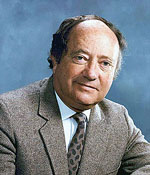February 17, 2009 - By Ruthann Richter

Thomas Merigan
HIV patients who received a new form of gene therapy showed modest but transient improvements in their disease, the first step in what could be a new approach to HIV treatment, say medical school researchers.
In the trial, researchers effectively inserted an anti-HIV gene into patients' stem cells and observed that these patients were somewhat protected against the disease when compared with those in a control group, said Thomas Merigan, MD, the George and Lucy Becker Professor of Medicine, emeritus, and an author of the study. Merigan collaborated in the multi-center trial with researchers at UCLA and St. Vincent's Hospital in Sydney, Australia.
'This is an indication that this kind of therapy could someday be useful,' Merigan said. 'It has to be much more perfected. But in the way we set up the trial with randomized placebo controls, we could dissect out that there was a positive effect in patients who had the gene successfully installed.
'This could be a first step in developing a new method of controlling a chronic infectious disease,' he added. The results appeared in the Feb. 15 online edition of Nature Medicine.
The study is the first randomized, controlled trial using gene therapy to treat HIV. It involved 74 patients - 42 in the United States and 32 in Australia - who had moderately advanced disease. The volunteers were a diverse group of men and women between the ages of 26 and 45. All were on standard antiretroviral treatment when they enrolled in the study, which began in 2004.
In the study, the researchers extracted blood-forming stem cells from the volunteers. These are the cells that give rise to different immune system cells, including those targeted by the AIDS virus. These stem cells then were modified in the laboratory by a gene against tat, an enzyme needed for HIV to reproduce itself. The researchers used a disabled murine leukemia virus as a vehicle to insert the anti-tat gene into the cells.
These genetically modified cells then were infused back into half of the patients selected at random. The other half received a dummy injection. No one involved in the trial knew which patients had received the gene therapy and which had received the dummy injection until the results were unveiled in late 2008.
Within a month after receiving the gene therapy, 94 percent of the patients in the gene therapy group had measurable levels of the anti-tat gene in their peripheral blood, the researchers reported. By week 48, this figure had dropped to 12 percent.
Twice during the two-year study period, patients stopped taking their antiretroviral drugs so that researchers could independently measure the impact of the gene therapy.
They found that patients on gene therapy after stopping antiretroviral therapy for a time maintained higher numbers of CD 4 cells, the key immune system cells that are destroyed by HIV, Merigan said.
'There was more prolonged elevation of CD4 in patients who had the gene successfully put in,' he said.
The therapy had less overall impact on the patients' viral loads, or the amount of virus circulating in the blood. In the gene therapy group, there was a slower return to high levels, compared to those in the control group.
The researchers found no evidence of patients developing resistance to the therapy, a common problem with standard antiretroviral treatment.
The therapy was determined to be safe, with no reports of any adverse events or any deaths during the trial. The trial initially was delayed for two years because of early safety concerns. In 2002, two infants undergoing gene therapy developed leukemia. The National Institutes of Health, the Food and Drug Administration and other groups then initiated a review of safety issues in gene therapy studies. Ultimately they concluded that the immune systems of adults were different than those of infants, and thus adults should not face the same risks.
Merigan's Stanford co-author on the study was Mark Winters, a research assistant in infectious disease. The trial was sponsored by Johnson & Johnson, which manufactures the reagents used in the study.
About Stanford Medicine
Stanford Medicine is an integrated academic health system comprising the Stanford School of Medicine and adult and pediatric health care delivery systems. Together, they harness the full potential of biomedicine through collaborative research, education and clinical care for patients. For more information, please visit med.stanford.edu.